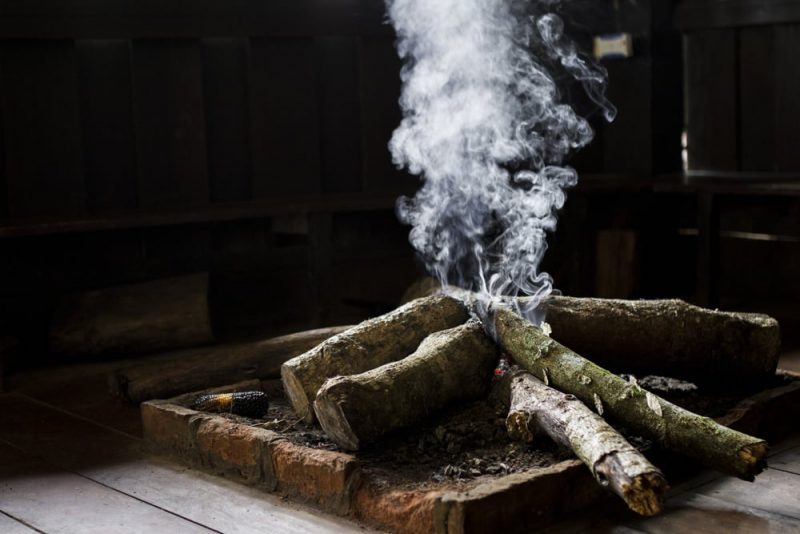The fuels They are substances that release energy in the form of heat when a chemical reaction called rapid oxidation occurs, which is also called “combustion.” For instance: mineral coal, gasoline, natural gas.
The energy released by fuels is in the form of potential energy in the bonds that join their molecules (binding energy).
The most commonly used fuels are:
- Mineral carbon (solid fuel). It is a rock that is obtained through mining. It is a non-renewable resource, that is, as it is consumed, its world reserves decrease (which cannot be replaced in millions of years).
- Wood (solid fuel). It comes from the trunk of trees and shrubs. The term “wood” refers to material that can be used for various purposes, such as construction and the manufacture of various products. When used as fuel it is often referred to as “firewood”. Although it could be considered a renewable resource (since trees can be planted again), the rate at which forests are being cut down is much greater than the rate at which they are being planted. Due to the great difference between consumption and production of the resource, we can consider wood a non-renewable resource. It is important to remember that forests are being cut down not only for the use of wood but also to use the cleared land as places for planting and building houses. Worldwide, the consequence of this is a phenomenon called desertification.
- Peat (solid fuel). It is an organic material of plant origin, which occurs as a result of the carbonization of vegetation. Its high carbon content (59%) is what makes it a fuel. It is used dried as a fuel for heating and for power generation, but it also has other uses (gardening, plant nutrition, etc.)
- Gasoline (derived from petroleum). It is a fuel for internal combustion engines. A lighter liquid is obtained from the distillation of petroleum. It is a mixture of multiple hydrocarbons. It is a non-renewable resource.
- Diesel, diesel or diesel (derived from petroleum). It is used as a heating fuel and for diesel engines. It is a liquid of higher density than gasoline. It is a non-renewable resource.
- Kerosene or kerosene (derived from petroleum). It is a fuel that was used in stoves and lamps, and currently in jet planes. It is also used as a solvent and in the manufacture of insecticides. It is a non-renewable resource.
- Natural gas. It is a fossil fuel, which can be found in independent fields or in oil or coal fields. It is preferable to other fossil fuels because less carbon dioxide is emitted in its use. It is used for heating by boilers, to make electricity and heat, and also as fuel for vehicles. It is a non-renewable resource and it is estimated that the current reserves worldwide will be consumed in the next 55 years. When we speak of natural gas we usually refer to methane gas, while when we speak of petroleum gases we refer to butane and propane gas.
- Alternative fuels. Many of the fuels commonly used are non-renewable. For this reason, alternatives are being sought through new combustible substances such as biodiesel, which are manufactured through the transesterification or esterification of vegetable oils. At the moment, these fuels require high manufacturing costs, so they are not yet widely used. However, research and technological advancement aim to turn them into more efficient alternatives.
Examples of fuels in everyday life

- Bonfires. When lighting a bonfire on the beach, in the forest or in a hearth with a fireplace, we use firewood (wood) as fuel. All combustion produces toxic waste, in the form of solids and gases. That is why whenever a bonfire is made in a closed place, there must be an outlet for these toxic gases. That is what chimneys are for.
- Electricity. Electrical energy can come from different sources, such as solar energy, wind energy or hydroelectric energy. However, in many towns and cities, fuels such as coal or petroleum products are used to generate electricity.
- Peddlers. Street vendors who use some kind of flame to prepare their product (popcorn, caramelised, etc.) often use kerosene in their burners.
- Buses. Buses use fuel to run. Because of their cost and performance, they most likely use diesel or CNG (compressed natural gas).
- Candles. The candles are made of natural wax or paraffin (a derivative of petroleum). The material surrounding the wick functions not only as support but also as fuel, which is consumed as the candle flame burns.
- Cars. Currently most of the means of transport require fuel for their operation. Most often they use gasoline, although there are many who use diesel, natural gas or alternative fuels.
- Make a tea. To prepare a tea we use fuels, usually methane gas to light our kitchens. All the more complex culinary preparations also use fuel, with the exception of electric cookers.
- Gas heating. Stoves usually use gas to heat the air or to heat water, which then heats the environment by circulating through the pipes installed around the rooms. In both cases, the gas works as fuel. The exception is electric stoves.
